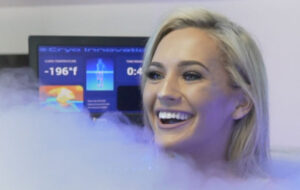WHAT IS CRYOTHERAPY ?
Simply stated Cryotherapy translates to “cold therapy.”

This ground-breaking and growingly popular form of treatment involves using liquid nitrogen to expose the entire body to temperatures below -220 F. While inside our whole body cryotherapy chamber, this extremely cold temperature will work to activate your body’s natural cell regeneration abilities while ridding the body of metabolic waste and harmful toxins. The benefits of cryotherapy are truly endless and many professional athletes and influential figures have publicly shared their excitement and personal experiences with the treatment!
If you suffer from fibromyalgia, painful injuries, arthritis, muscle soreness, back pain, or pain in the joints or ligaments, please don’t hesitate to contact us to begin your life-changing treatment right away! If you wish to jump-start your weight loss, achieve beautiful, healthy skin, increase your energy levels, combat fatigue; and work to improve stress, anxiety, and depression…you will be happy to learn that cryotherapy can help there too!
How does cryotherapy work?
Each session, lasts for up to 3 minutes. The chamber is filled with nitrogen gas, cooling the temperature to approximately -230°F. Over the course of the session, the skin’s surface is cooled to approximately 35° – 45°F. At this low temperature, your body’s survival instincts kick in. Endorphins and oxygen-rich blood are rapidly circulated throughout your entire body. White blood cells can then access and increase the rate of healing injuries up to five times faster once capillaries expand up to four times their natural diameter.
It it comfortable? What will I feel?
It is extremely cold… super-cold!
Dry air is circulated throughout the chamber, and over your skin throughout the 3-minute treatment.
What do I wear?
For best results, you will only wear essential protective clothing during the treatment, including gloves, clean dry socks, booties (all if which are provided) and your dry undergarments (for women a sports bra is recommended, no underwire bras).
Make sure your skin is clean, clear and dry.
Do not wear any lotions, oils or sprays on your body to avoid frostbite.
How regularly should I have treatment?
Session frequency will vary based on the type of condition that is being treated.
Generally, the first two weeks will call for five to ten treatments scheduled in close succession, one every other day. After this initial series, one treatment per week will maintain the therapy.
Whole Body Cryotherapy is ideal for those pursuing overall improved health and wellness. Athletes seeking improved muscle recovery, those with persistent pain and inflammatory conditions, and even those seeking weight loss and skin renewal can all benefit from cryotherapy.
Used post-surgery, cryotherapy can help fast-track healing and lessen pain without prescription drugs or their side-effects.
How does cryotherapy treatment compare to an ice bath?
Just 2-3 minutes of Cryotherapy is more beneficial that 20-30 minutes submerged in an ice bath. The body benefits when the nitrogen vapor chills the top layers of skin, then cold receptors lower the outer body temp to 35°F-45°F. It is at this degree of cold that the brain restricts blood flow to your extremities and the body’s flight or fight instinct takes over. It is this reaction to Whole Body Cryotherapy that boosts the release of endorphins and anti-inflammatory proteins and creates super-charged blood.
Is nitrogen harmful to humans?
No. The air we breathe is composed of 16% Oxygen, 1% Hydrogen, 78% Nitrogen and 5% of other components. Nitrogen is a non-toxic gas.
Are there any age restrictions?
Treatment is restricted to ages 13 and above. Parental consent is required for those ages 13-18. It is recommended that those aged 13 – 16 should have a referral from a physician.
Who should not use cryotherapy treatment?
The following are restrictions and contraindications for Whole Body Cryotherapy:
Pregnancy, untreated hypertension (BP 180/100) , heart attack within previous 6 months, ischemic heart disease, congestive heart failure, COPD, tumor diseases, chronic liver disease, unstable angina pectoris, pacemaker, deep vein thrombosis or known circulatory dysfunctions, acute febrile respiratory conditions, seizure disorders, acute kidney and urinary tract infections, severe anemia, Raynaud’s disease, open sores, vasculitis, hyperhidrosis or uncontrolled diabetes.










